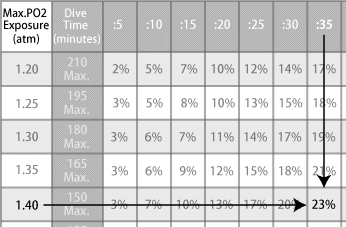
Nitrox specialty
Certification card
Medical check
Nitrox and air
Diving equipment for nitrox
Nitrox characteristic
Prevent oxygen poisoning 1
Prevent oxygen poisoning 2
Prevent oxygen poisoning 3
Health management
Dive plans and dive table
|

|
■Diving time management for repetitive dive per day
If you take less than 24 hours of surface interval from the last dive and perform the second dive, the oxygen absorbed by the last dive has been accumulated in the body.
For the second and subsequent dives, the amount of oxygen accumulated in the body after the first dive must be taken into consideration.
Since the dive time and the dive depth may differ for each dive, calculate the oxygen absorption amount before diving using the oxygen ratio exposure table and obtain the oxygen exposure limit for the next dive.
For example, what is the oxygen exposure limit when using EAN36 to dive
to 28 m depth for 30 minutes, taking a surface interval and then using EAN36 to dive
to 28 m depth for the second dive?
In the first dive, the oxygen ratio of EAN36 is 0.36, so using the calculation formula,
oxygen partial pressure = 0.36 (28/10 + 1) = 1.386.
In the leftmost column of the table, look for the closest number above 1.386.
1.40 is the closest number.
The oxygen exposure time is stated at 5 minute intervals in the right column, and the oxygen exposure limit ratio in the 35 minute * column is 23%.
This indicates that there is still a 77% margin until the oxygen exposure time.
※ For safety reasons, the oxygen exposure time should be considered as less than 5 minutes, less than 10 minutes, less than 15 minutes, etc.
So if you dive for 30 minutes, you'll see the next larger column ":35", not the exact column for ":30".
|
 |
|
The oxygen ratio of the second dive is the same as the first dive one, so follow the column for oxygen partial pressure 1.40 to the right and look for 77% of your oxygen exposure limit.
This table only describes oxygen exposure limit ratios up to 40%, so the oxygen exposure limit time is 59 minutes * of 40% oxygen exposure limit ratio.
※ For safety reasons, the oxygen exposure time should be considered as less than 5 minutes, less than 10 minutes, less than 15 minutes, etc.
Therefore, the oxygen exposure time of ":60" means less than 60 minutes, oxygen exposure limit is 59 minutes.
|
 |
Also, what is the oxygen exposure limit, when using EAN36 to dive to 28 m depth for 30 minutes, taking a surface interval, then using EAN36 to dive to 28 m depth for 30 minutes, taking a surface interval, then using EAN36 to dive to 28 m depth?
In the first dive, the oxygen ratio of EAN36 is 0.36, so using the calculation formula,
oxygen partial pressure = 0.36 (28/10 + 1) = 1.386.
In the leftmost column of the table, look for the closest number above 1.386.
1.40 is the closest number.
The oxygen exposure time is stated at 5 minute intervals in the right column, and the oxygen exposure limit ratio in the 35 minute * column is 23%.
This indicates that there is still a 77% margin until the oxygen exposure time.
※ For safety reasons, the oxygen exposure time should be considered as less than 5 minutes, less than 10 minutes, less than 15 minutes, etc.
So if you dive for 30 minutes, you'll see the next larger column ":35", not the exact column for: 30.
|
 |
Since the oxygen ratio of the second dive is the same as the first dive one, the oxygen exposure limit ratio is 23%.
The oxygen exposure limit ratio at the end of the second dive is the sum of the oxygen exposure limit ratio after the first dive and the oxygen exposure limit ratio after the second dive.
The oxygen exposure limit ratio at the end of the second dive is 23% + 23% = 46%.
This indicates that there is still a 54% margin until the oxygen exposure time limit.
The oxygen ratio of the third dive is the same as the second dive one, so follow the column for oxygen partial pressure 1.40 to the right and look for 54% of your oxygen exposure limit.
This table only describes oxygen exposure limit ratios up to 40%, so the oxygen exposure limit time is 59 minutes * of 40% oxygen exposure limit ratio.
※ For safety reasons, the oxygen exposure time should be considered as less than 5 minutes, less than 10 minutes, less than 15 minutes, etc.
Therefore, the oxygen exposure time of ":60" means less than 60 minutes, oxygen exposure limit is 59 minutes.
|

|
A specialized American agency recommends a surface interval of 90 minutes or longer to reduce the risk of oxygen poisoning. |
 |
|
|
  |
|

